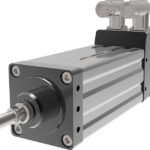Moticont has released a new three-axis XYZ linear actuator, the XYZ-10. The X and Y axis of the actuator each has 0.97 in. (24.6 mm) of travel and the Z axis has a stroke of 0.500 in. (12.7 mm). The high-speed, high-acceleration, zero-cogging, brushless voice coil motors provide 6.3 lb (28.2 N) of force and […]
Actuators
Low-power voice-coil actuator for cryogenic environments
H2W Technologies’ new high-force, non-commutated dc linear actuator, otherwise known as a direct-drive voice-coil actuator, is designed specifically for use in cryogenic environments. Material choice and design parameters were implemented such that the motor can operate without degradation or damage when placed in a cryogenic environment. The model NCC14-78-830-1SM can generate a continuous force of […]
New integrated motor/actuator series from Curtiss-Wright
Curtiss-Wright’s Sensors & Controls Division recently announced the release of the Exlar GTX080 next-generation integrated motor/actuator. The GTX080’s latest design offers substantial performance improvements over its predecessor. Incorporating Curtiss-Wright’s patented inverted roller screw technology, the GTX080’s high power density and compact form factor make it an ideal replacement for hydraulic cylinders. The GTX Series actuators […]
Warner Linear debuts H-Track actuators for mobile and industrial applications
Warner Linear has developed a new H-Track electric actuator with self-contained hydraulic actuation to meet the growing demand for power dense actuators used in a variety of industrial and mobile off-highway applications including mower deck lifts, snow plow blades, agricultural sprayer booms, and UTV dump beds. The innovative electric H-Track actuator provides the performance of […]
Parker announces North American production of high moment rodless linear actuator series
Now manufactured in the USA, the HMR attains greatly improved lead times and new customization options. Parker’s Electromechanical Automation Division, a leading supplier of motion control technology, is pleased to announce the domestic manufacturing for the complete line of High Moment Rodless (HMR) electromechanical linear actuators. “This move will serve to greatly improve product lead times […]
New economical linear slide from PHD
Built on the foundation of long-life products for industrial automation, PHD Optimax actuators are designed to meet machine builders’ performance requirements at a competitive prices. These economical, efficient, and reliable actuators provide an alternative choice to PHD’s standard “built-to-order” product line, delivering even more cost-effective solutions to meet industrial application needs. In a continuing effort […]
A selection guide for linear systems
Gone are the days when machine designers and builders had to choose between constructing their own linear system from scratch or settling for a limited range of pre-assembled systems that, in most cases, were an imperfect fit for their application. Manufacturers today offer systems based on a range of drive mechanisms—ball screws, belts, rack and pinions, linear motors, […]
New video demonstrates how to synchronize multiple lifting columns
Thomson Industries, Inc., a leading manufacturer of mechanical motion control solutions, has released a new video to demonstrate how design engineers can synchronize multiple Thomson Lifting Columns quickly and easily. The compact design of Thomson Lifting Columns provides a favorable ratio between stroke and retracted length to improve operator ergonomics. Models are designed to handle moment loads […]
When Do You Need a Gantry Robot?
When you think of an industrial robot, what comes to mind? Probably something like this… Articulated robots like these are widely recognized, thanks to car company commercials and robot dance sequences. SCARA (Selective Compliance Articulated Robot Arm) robots are also well-recognized due to their adoption and proliferation in factories since the early 1980’s. Both of these – articulated […]
Inertia Matching: Why Perfect Isn’t Always Best
Inertia matching is one of the inexact sciences of motion system design. When a motor and a load are coupled together, the ratio of load inertia to motor inertia determines how well the motor can control the load during acceleration and deceleration. In theory, a “perfect” inertia match of 1:1 (load inertia equals motor inertia) should […]










